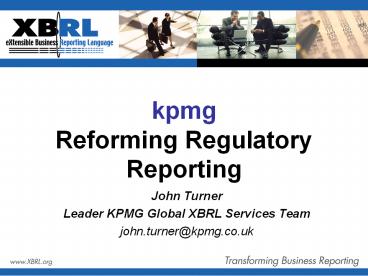kpmg Reforming Regulatory Reporting - PowerPoint PPT Presentation
Title:
kpmg Reforming Regulatory Reporting
Description:
Walking the tight rope. Reaching common understanding. Evolution of regulatory reporting ... Regulation, and government as a whole, cannot exist without ... – PowerPoint PPT presentation
Number of Views:199
Avg rating:3.0/5.0
Title: kpmg Reforming Regulatory Reporting
1
kpmgReforming Regulatory Reporting
- John Turner
- Leader KPMG Global XBRL Services Team
- john.turner_at_kpmg.co.uk
2
Topic Outline
- Walking the tight rope
- Reaching common understanding
- Evolution of regulatory reporting
- Why XBRL?
3
Walking the tightrope
- Regulation, and government as a whole, cannot
exist without information from private
corporations - Lots of information
- No really
- Lots and lots of information
- This is variously estimated as around 0.6 of
GDP. - gt 8 Billion hours per annum in the US alone
- Regulators must balance their legitimate
information needs against this provider burden.
4
An ongoing balancing act
- Viewed as a whole, regulators appear to move
between favouring industry and favouring
government in terms of their data collections. - Both extremes are undesirable for all concerned
- Reasons are complex, but include regulatory
policy taking its lead from altering community
expectations
5
Topic Outline
- Walking the tight rope
- Reaching common understanding
- Evolution of regulatory reporting
- Why XBRL?
6
Six principles for regulatory reporting
requirements
- Timely
- To be useful, information needs to be available
within a reasonably short period from the time of
measurement. The rear view mirror view of any
qualitative measure is only useful where
information is currentand its currency rapidly
fades. - Accurate
- Information should be free of data anomalies and
errors and tested for manipulations. - Reasonable
- Regulators should seek to minimize provider
burden (the amount of effort imposed on the
regulated community by the scope of the data
collection). - Relevant
- The definitions and interrelationships between
data definitions need to be up to date and as
tightly linked to information used for the
running of the business as possible. - Efficient
- The cost of collecting the information needs to
be proportionate to the value of the data
collected. - Transforming
- Legitimate governmental information needs change
markedly over time. Sometimes information
collections are allowed to go stale as a result
of a policy that favours the private sector.
Stale information is resented, and eventually
ignored by users, or, perhaps worse, is assumed
to remain relevant by agency analysts, who
quickly become out of touch with industry
developments.
7
Reaching common understanding
- Headline
- People turn to XBRL to help exchange information
between systems. - The sub-text
- In order to exchange information you need to
understand it. - Understanding metadata turns out to be tough.
- XBRL can help provide a consistent view of all
the information that is used around the
enterprise (or across enterprises) - This is a way to componentise business activity
without replacing systems
8
Topic Outline
- Walking the tight rope
- Reaching common understanding
- Evolution of regulatory reporting
- Why XBRL?
9
Evolving processes for data collection
10
Paper Bound Unusable data
- The process of designing and deploying
paper-based data collections is, of course,
pretty simple. - The actual use of paper-based data is
problematic!
11
Program Bound Continuous Programming
- In this mode, the process of implementing the
decisions made about regulatory reporting
requirements involve - Providing the Excel and Word (eg paper) versions
of the information requirements to the systems
development team. - These requirements get coded (by hand) into
electronic forms. - This goes backwards and forwards between the
business and technology groups until the forms
are right.
12
Adaptive Improvement by the Business
- An Adaptive system is designed with a view to
the need to make changes as being one of the key
features of the business environment. - By building requirements in a format that are
human readable as well as understandable by a the
system, the business experts get very fine-grain
control over the creation of the form. - It also imposes new levels of discipline over the
creation of the regulatory reporting
requirements, with business experts able to share
the requirements with a range of stakeholders
(internally and externally) in a very precise way.
13
Topic Outline
- Walking the tight rope
- Reaching common understanding
- Evolution of regulatory reporting
- Why XBRL?
14
Six principles for regulatory reporting
requirements revisited
- Timely
- Accurate
- Reasonable
- Relevant
- Efficient
- Transforming































